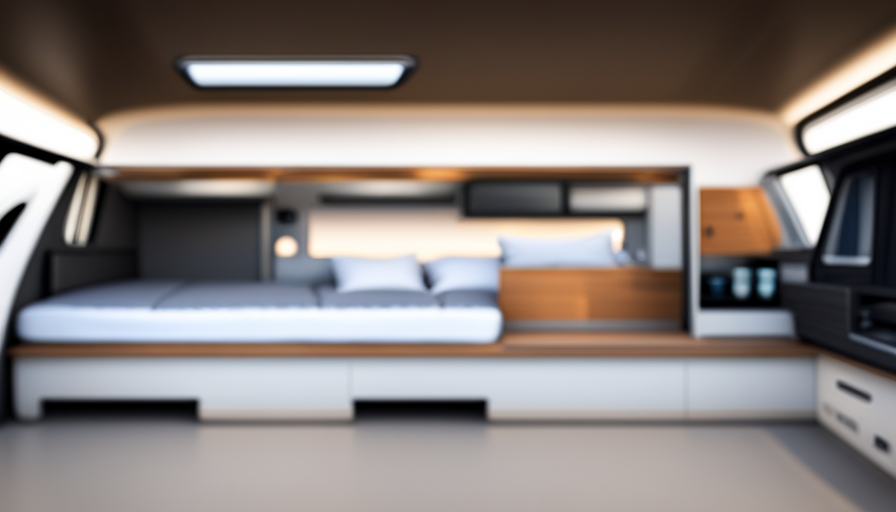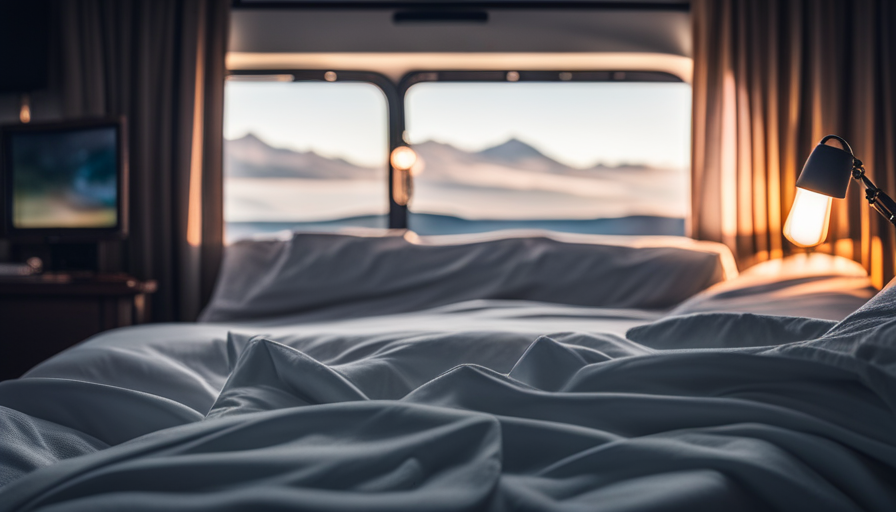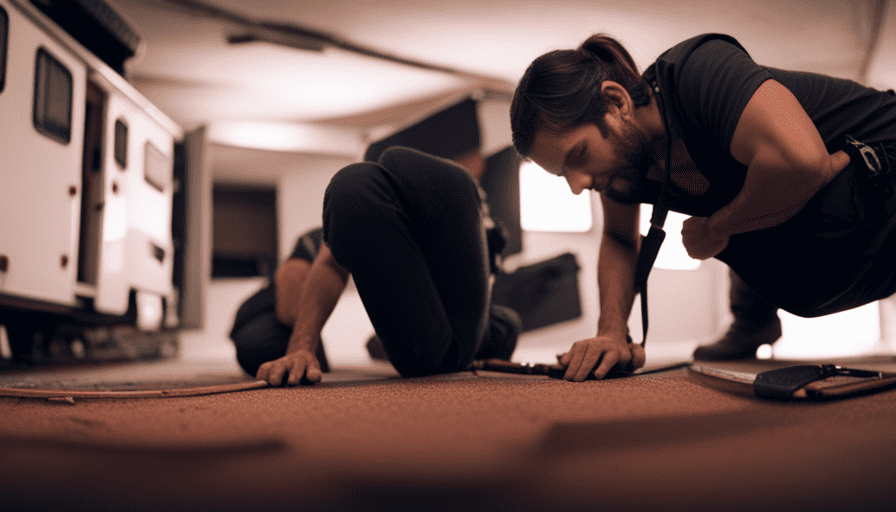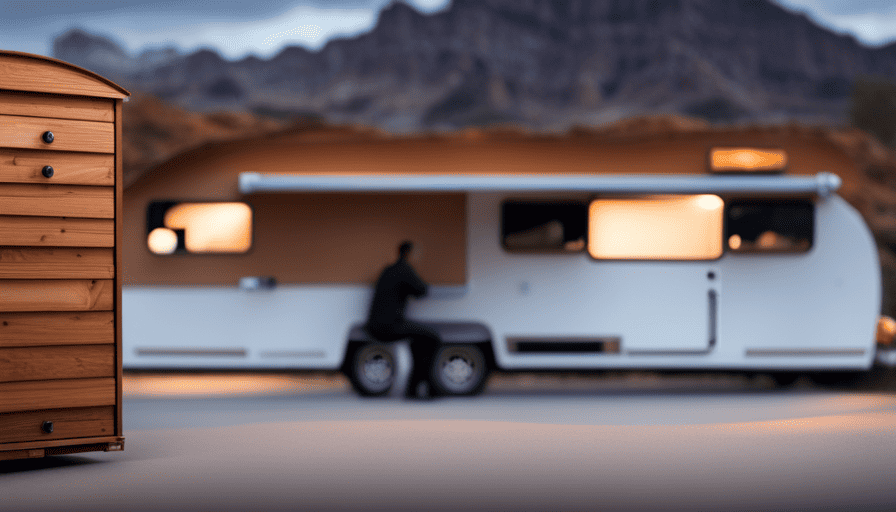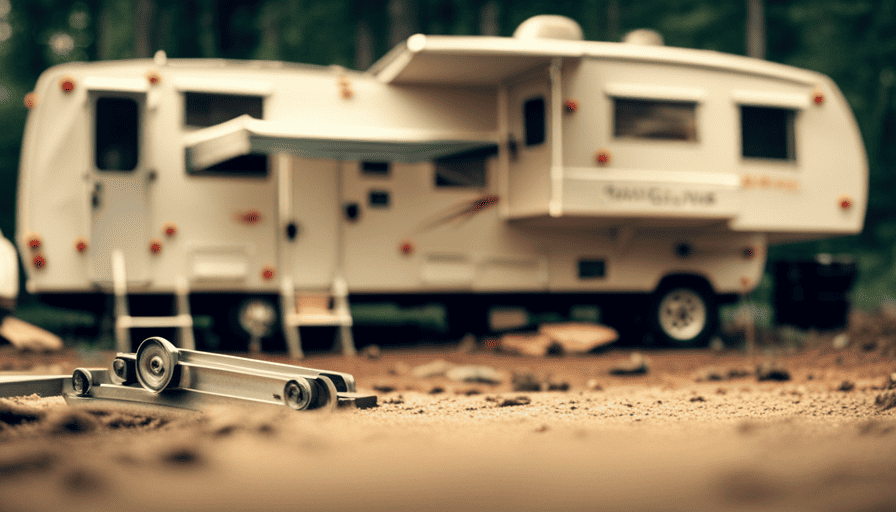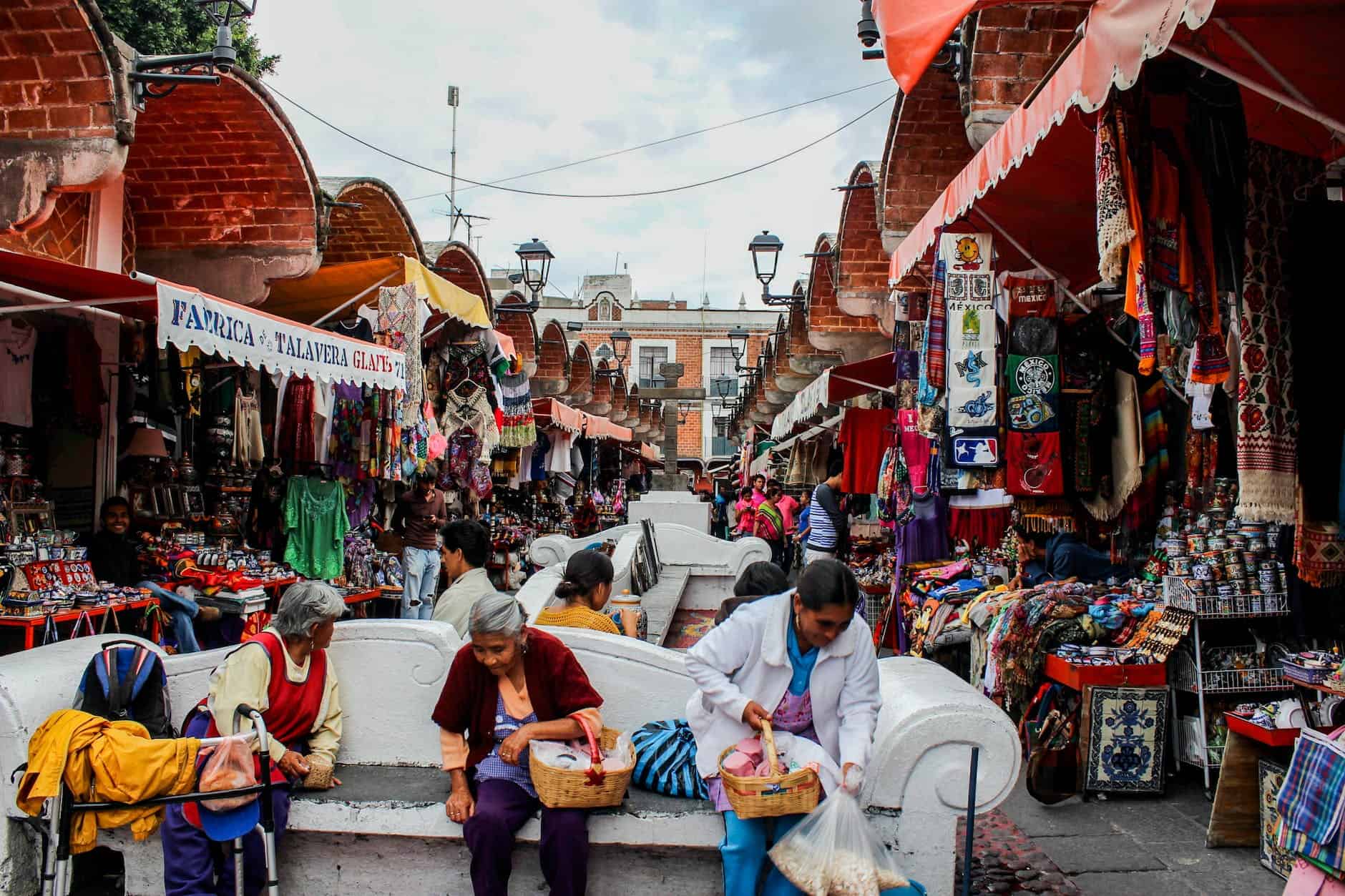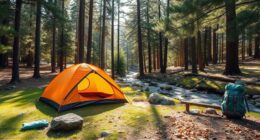Were you aware that more than 500,000 individuals in the United States are currently residing in camper vans? It’s not shocking that van conversions have gained popularity as a trend, providing the freedom and flexibility to travel and explore the world on your own terms. However, with numerous options available, which van would be the ideal choice for your conversion?
In this article, we will delve into the top contenders, including the Mercedes-Benz Sprinter, Ford Transit, Volkswagen Transporter, Ram ProMaster, Nissan NV200, Toyota Hiace, Fiat Ducato, Mercedes-Benz Vito, and Citroen Relay. As experienced van enthusiasts, we have researched and tested these models extensively, providing you with an unbiased and knowledgeable perspective. Whether you’re a weekend warrior or a full-time nomad, we will help you make an informed decision on the best van to convert into your dream camper.
So, let’s hit the road and dive into the world of van conversions!
Key Takeaways
- Spacious interior and customization options are important factors to consider when choosing a van for camper conversion.
- Strong build quality and durability features ensure reliability and longevity in the camper.
- Compact size allows for easier maneuverability and parking in urban areas or tight campsites.
- High-quality insulation, sturdy construction, and weather-resistant exterior materials are essential for a comfortable and well-protected camper.
Mercedes-Benz Sprinter
If you’re looking for a top-notch van to transform into your dream camper, look no further than the Mercedes-Benz Sprinter. The Mercedes Benz Sprinter is one of the most popular choices for camper van conversions, and for good reason.
With its spacious interior, excellent build quality, and reliable performance, the Sprinter is a camper van enthusiast’s dream.
One of the major advantages of the Mercedes Benz Sprinter is its versatility. It comes in various configurations, allowing you to choose the one that suits your needs best. Whether you’re looking for a compact van for solo adventures or a larger one for family trips, the Sprinter has got you covered.
When it comes to camper van modifications, the Mercedes Benz Sprinter is a favorite among enthusiasts. Its sturdy frame and ample space make it easy to install all the necessary amenities, from a comfortable bed to a functional kitchenette. Plus, the Sprinter’s reputation for durability ensures that your camper van will last for years to come.
Of course, like any vehicle, the Mercedes Benz Sprinter has its pros and cons. While its performance and reliability are top-notch, the Sprinter can be a bit pricier compared to other van options. Additionally, its size can make it more challenging to maneuver in tight spaces.
Transitioning to the subsequent section about the Ford Transit, another popular van for camper conversions, let’s explore its features and advantages.
Ford Transit
When looking for a versatile option to create your dream mobile home, you can’t go wrong with the Ford Transit. As one of the best vans available for conversion, the Ford Transit offers a perfect combination of space, reliability, and customization options.
Its spacious interior provides ample room for all your camper essentials, allowing you to design a layout that suits your specific needs and preferences.
The Ford Transit’s reputation for durability and dependability makes it a popular choice among camper van enthusiasts. Its powerful engine and sturdy construction ensure a smooth and comfortable ride, whether you’re exploring off-road trails or cruising on the highway.
With its wide range of available features and upgrades, you can easily transform the Ford Transit into a fully-equipped camper that suits your lifestyle.
What sets the Ford Transit apart from other vans is its impressive fuel efficiency, making it not only an excellent choice for long road trips but also a cost-effective option for daily use. Its advanced safety features provide peace of mind while on the road, ensuring a safe and enjoyable travel experience.
Now, let’s move on to the next contender in our search for the best van to convert into a camper: the Volkswagen Transporter.
Volkswagen Transporter
The Volkswagen Transporter offers a unique and exciting opportunity to create your ultimate mobile adventure. With its fuel efficiency and compact size, this van is perfect for those looking to explore the great outdoors without sacrificing comfort or convenience.
One of the key advantages of the Volkswagen Transporter is its impressive fuel efficiency. Whether you’re planning a cross-country road trip or a weekend getaway, this van will help you save money on gas. With its efficient engine and aerodynamic design, you can enjoy long drives without constantly worrying about refueling.
In addition to its fuel efficiency, the compact size of the Volkswagen Transporter makes it easy to maneuver in both urban and rural areas. Whether you’re navigating narrow city streets or winding mountain roads, this van will effortlessly take you wherever you want to go. Its compact size also makes it easier to find parking spots, allowing you to explore new destinations with ease.
Overall, the Volkswagen Transporter is a reliable and versatile option for anyone looking to convert a van into a camper. Its fuel efficiency and compact size make it an ideal choice for those seeking adventure on the road.
Now, let’s delve into the next section and explore the benefits of the Ram Promaster.
Ram ProMaster
The Ram ProMaster is an excellent option to consider for converting into a camper due to its ample cargo space for storage. It’s wide and tall interior provides plenty of room to store all your camping gear and necessities.
Additionally, the ProMaster is easy to drive and park, making it a practical choice for both city and off-road adventures.
Lastly, its affordable base price and reasonable conversion costs make it a budget-friendly option for those looking to create their dream camper van without breaking the bank.
Ample Cargo Space for Storage
You’ll love the Nissan NV Cargo van for your camper conversion because it offers an impressive 234 cubic feet of cargo space. This gives you plenty of room to store all your camping gear and equipment. With ample cargo space for storage, organization and accessibility become a breeze.
The Nissan NV Cargo van allows you to easily arrange and access your belongings, ensuring that everything is within reach when you need it. Additionally, its spacious interior allows for creative and innovative storage solutions for maximizing space utilization. You can install shelves, hooks, and other storage accessories to keep your belongings organized and secure during your camping adventures.
The Nissan NV Cargo van’s generous cargo space makes it a top choice for camper conversions. Transitioning into the next section, you’ll also appreciate how easy it is to drive and park this versatile van.
Easy to Drive and Park
Experience the freedom and convenience of effortlessly maneuvering through narrow city streets and easily finding parking spots with the Nissan NV Cargo van. Its compact size allows for easy navigation, making it an ideal choice for those seeking an easy-to-drive and park camper van.
Whether you’re exploring bustling urban areas or navigating winding country roads, the Nissan NV Cargo van provides a smooth and stress-free driving experience. Additionally, its off-road capabilities ensure that you can venture off the beaten path and explore remote destinations with ease.
Now, let’s transition into discussing the affordability of the Nissan NV Cargo van and its conversion costs.
Affordable Base Price and Conversion Costs
With its competitive base price and reasonable conversion costs, the Nissan NV Cargo van presents a cost-effective option for those looking to transform it into a camper. The van offers affordable customization options, making it an attractive choice for budget-conscious individuals.
Whether you choose to tackle the conversion yourself or hire a professional, the NV Cargo van provides a solid foundation for a camper transformation.
In terms of DIY conversions, the NV Cargo van offers ample space for customization, allowing you to create a unique and personalized camper experience. From installing a bed and storage compartments to adding a kitchenette or bathroom, the possibilities are endless.
For those who prefer a professional conversion, the NV Cargo van is compatible with various conversion companies that specialize in transforming vans into campers. They can handle all aspects of the conversion, from insulation and electrical work to custom furniture and amenities.
Transitioning to the subsequent section about the Nissan NV200, this compact van offers similar affordability and customization options for camper conversions.
Nissan NV200
The Nissan NV200 is a compact and maneuverable van that’s perfect for urban adventures. It’s small size allows for easy parking and navigating through tight city streets.
Additionally, the NV200 offers great fuel efficiency, making it an ideal choice for long-distance travel without breaking the bank.
Lastly, the affordable price point of the NV200 makes it a budget-friendly option for those looking to convert a van into a camper.
Overall, the NV200 is a practical and versatile choice for anyone seeking a compact and fuel-efficient camper van.
Compact and Maneuverable for Urban Adventures
Choose a compact and maneuverable van for your urban adventures, and picture yourself effortlessly navigating through the bustling city streets. The Nissan NV200 is an excellent choice in this regard, as its small size and agile handling make it a breeze to maneuver in tight spaces.
Whether you’re trying to find a parking spot or weaving through traffic, this van’s maneuverability benefits will truly enhance your urban camping experience. Speaking of which, urban camping poses its own unique set of challenges, and having a compact and nimble van like the NV200 can make all the difference.
From navigating narrow streets to finding discreet places to park overnight, this van is tailor-made for urban adventures. And when it comes to fuel efficiency for long-distance travel, the NV200’s efficient engine ensures that you can go the distance without breaking the bank.
Fuel Efficiency for Long-Distance Travel
Imagine effortlessly cruising down the highway in the Nissan NV200, its efficient engine allowing you to travel long distances without worrying about fuel consumption.
When it comes to fuel efficiency for long-distance travel, there are a few tips and cost-effective modifications that can make a significant difference. First, consider upgrading to low rolling resistance tires, which reduce friction and improve fuel economy. Additionally, optimizing the van’s weight by removing unnecessary items and installing lightweight materials can also enhance fuel efficiency. Another effective strategy is to maintain a steady speed and avoid rapid acceleration or braking.
By following these fuel efficiency tips and making cost-effective modifications, you can ensure that your van conversion remains efficient and economical for those unforgettable road trips.
Speaking of economy, let’s now delve into the subsequent section about the affordable price point for budget-friendly conversions.
Affordable Price Point for Budget-Friendly Conversions
When it comes to converting a van into a camper, fuel efficiency is not the only factor to consider. Affordability is equally important, especially if you’re on a budget. Luckily, there are plenty of affordable design options and space optimization techniques available to help you create a camper that fits your needs without breaking the bank.
When it comes to affordability, it’s all about finding the right balance between cost and quality. Look for vans that offer a good base for conversion at a reasonable price point. Consider models that have a spacious interior, allowing you to maximize the use of every inch. From clever storage solutions to versatile furniture, there are endless possibilities to make the most out of your camper van conversion.
Now, let’s delve into the specifics of one popular van model that ticks all the boxes for an affordable and practical conversion: the Chevrolet Express.
Chevrolet Express
The Chevrolet Express is the perfect van to turn into a cozy camper, with its spacious interior and rugged reliability. With ample cargo space, this van provides plenty of room to store all your camping gear, from sleeping bags to cooking equipment.
The high roof option allows for even more headroom and the ability to stand up comfortably inside.
Not only does the Chevrolet Express offer generous space, but it’s also easy to drive. The smooth handling and responsive steering make maneuvering this van a breeze, whether you’re navigating narrow campsite roads or cruising down the highway. Its powerful engine ensures that you have enough horsepower to conquer any terrain.
In addition to its practicality, the Chevrolet Express is known for its reliability. It’s built to withstand the demands of long road trips and outdoor adventures, making it a dependable choice for your camper conversion.
Transitioning into the subsequent section about the Toyota Hiace, another popular van for conversions, you’ll find that the Chevrolet Express is a tough competitor. However, if you’re looking for a van with a more compact size and fuel efficiency, the Toyota Hiace might be the perfect fit for your camper conversion needs.
Toyota Hiace
Get ready to experience the ultimate in compact and fuel-efficient versatility with the Toyota Hiace. As a popular choice among van converters, the Hiace offers numerous advantages that make it an ideal candidate for a camper conversion.
First and foremost, the Hiace is known for its reliability and durability. With its strong build quality and robust engine, you can trust that this van will withstand the rigors of long road trips and off-grid adventures.
Next, the Hiace boasts excellent fuel efficiency, making it a cost-effective option for those seeking to minimize their environmental impact and save on gas expenses.
Moreover, the Hiace comes with a wide range of layout options, allowing you to customize the interior space to suit your specific needs. Whether you prefer a compact layout with a cozy sleeping area or a more spacious design with a kitchenette and bathroom, the Hiace can accommodate your preferences.
In addition, the Hiace offers ample storage space, ensuring that you can bring along all your camping gear and essentials without feeling cramped.
Lastly, the Hiace has a reputation for its smooth and comfortable ride, making it a joy to drive on both highways and winding country roads.
Now, let’s move on to the next contender in the search for the best van to convert into a camper: the Fiat Ducato.
Fiat Ducato
With its spacious interior and versatile layout options, the Fiat Ducato offers endless possibilities for transforming it into the camper of your dreams. The compact size of the Ducato makes it easy to maneuver on narrow roads and fit into tight camping spots. This is especially important when exploring remote areas or camping in crowded campgrounds.
Additionally, the fuel efficiency of the Ducato ensures that you can travel long distances without worrying about constantly refueling. The Fiat Ducato’s compact size doesn’t compromise on comfort and functionality. It provides ample space for a comfortable sleeping area, a compact kitchenette, and a functional bathroom.
The layout options are customizable, allowing you to create a camper that suits your specific needs and preferences. Whether you prefer a cozy and intimate camper or a more spacious and open layout, the Fiat Ducato can accommodate your desires.
Transitioning to the next section, the Mercedes-Benz Vito offers its own unique advantages for camper conversion.
Mercedes-Benz Vito
Now let’s shift our focus to another popular option for converting a van into a camper: the Mercedes-Benz Vito. As someone who’s delved into the world of campervan conversions, I can confidently say that the Vito has a lot to offer.
One of the standout features of the Vito is its affordable customization options. Whether you’re looking to create a cozy sleeping area or a compact kitchenette, the Vito provides ample space and flexibility for your design ideas. With its versatile layout, you can easily transform this van into a comfortable home on wheels without breaking the bank.
Additionally, the Vito boasts impressive fuel efficiency for city driving. This is a crucial factor to consider, especially if you plan on using your campervan for urban adventures or everyday commuting. The Vito’s efficient engine ensures that you can explore city streets without constantly worrying about fuel consumption.
Now that we’ve explored the benefits of the Mercedes-Benz Vito, let’s move on to another contender in the world of campervan conversions: the Citroen Relay. This van offers its own set of unique features and advantages.
Citroen Relay
When considering affordable options for converting a van into a camper, the Citroen Relay is a strong contender. It offers a great starting point for those on a budget, with its reasonable price point. Additionally, the spacious interior provides ample room for comfortable living. This allows you to easily customize and create a cozy home on wheels. Finally, the strong build quality of the Citroen Relay ensures durability and reliability. It gives you peace of mind during your adventures on the road.
Affordable Price Point for Budget Conversions
Although cost is often a major factor, finding the ideal van for a budget-friendly camper conversion can be a bit of a shell game. When considering an affordable price point, it’s important to prioritize fuel efficiency and compact size.
Opting for a van with good fuel efficiency can save you money in the long run, as it will require less frequent visits to the gas station. Additionally, a compact size allows for easier maneuverability and parking, especially in crowded urban areas or tight campsites.
However, it’s essential to strike a balance between budget and quality when searching for the perfect van. In the next section, we will explore how a spacious interior can provide comfortable living quarters for your camper conversion.
Spacious Interior for Comfortable Living
Creating a comfortable living space inside a camper requires a spacious interior that allows for relaxation and ease of movement. When considering the best van to convert into a camper, it’s important to prioritize a spacious layout design. This will provide ample room for sleeping, cooking, and lounging, ensuring a comfortable experience on the road.
Additionally, interior customization options are crucial in making the space truly your own. From customized storage solutions to modular furniture, these options allow you to optimize the interior to fit your specific needs and preferences.
Transitioning to the next section, a strong build quality for durability and reliability is equally important in ensuring a successful camper conversion.
Strong Build Quality for Durability and Reliability
A sturdy construction guarantees a reliable and long-lasting camper, providing peace of mind during your adventurous journeys. When converting a van into a camper, it’s crucial to choose one with a strong build quality.
Here are some durability benefits and long-lasting materials that contribute to a robust camper:
-
Reinforced frame: A van with a reinforced frame can withstand the rigors of the road, ensuring stability and durability even on rough terrains.
-
High-quality insulation: Investing in insulation made from long-lasting materials such as foam or fiberglass ensures that your camper remains comfortable and well-insulated for years to come.
-
Durable flooring: Opt for durable flooring materials like vinyl or hardwood that can withstand heavy foot traffic and are resistant to wear and tear.
-
Weather-resistant exterior: A camper with weather-resistant materials like aluminum or fiberglass ensures protection against the elements, enhancing the longevity of your van conversion.
Choosing a van with these durability features will ensure that your camper remains reliable and can withstand the adventures that lie ahead.
Frequently Asked Questions
How much does it cost to convert a van into a camper?
Converting a van into a camper can vary in cost depending on factors like the size of the van, desired amenities, and DIY skills.
A cost breakdown typically includes expenses for insulation, flooring, electrical system, kitchen, bathroom, and furnishings.
Common challenges during the conversion process include limited space, finding suitable materials, and ensuring proper ventilation.
However, with careful planning and research, it’s possible to create a comfortable camper that suits your needs and budget.
What are the most important factors to consider when choosing a van to convert into a camper?
When considering a van for conversion into a camper, two key factors to keep in mind are the cost of the conversion and the layout of the van.
On average, converting a van into a camper can cost anywhere from $5,000 to $30,000, depending on the extent of the modifications.
As for the layout, it’s important to choose a design that maximizes space efficiency and meets your specific needs, whether that’s a bed, kitchenette, or storage area.
Are there any legal requirements or regulations to consider when converting a van into a camper?
When converting a van into a camper, it’s important to consider the legal requirements and building codes that may apply.
These regulations vary by jurisdiction, so it’s crucial to research and comply with the specific rules in your area.
Common requirements may include proper insulation, ventilation, electrical systems, and the installation of safety features like smoke detectors. Failing to meet these requirements could result in fines or even the inability to use your converted van as a camper.
Can a van be converted into a camper by someone with no previous DIY experience?
When it comes to converting a van into a camper with no previous DIY experience, there are certainly challenges to be aware of. However, don’t let that discourage you! With the right mindset and some helpful tips, it’s definitely possible.
One benefit for beginners is the opportunity to customize your space to suit your needs. Whether it’s a cozy bed or a functional kitchenette, the possibilities are endless. Just be prepared to tackle the challenges head-on and enjoy the process of creating your own unique camper.
Are there any specific tools or equipment needed for van conversion?
Essential equipment for camper van conversion includes a variety of van conversion tools. Some of the most important tools are a jigsaw, drill, and angle grinder for cutting and shaping materials.
Additionally, you’ll need measuring tools like a tape measure and level, as well as basic hand tools like screwdrivers and wrenches.
Other equipment such as a power inverter, solar panels, and insulation materials are also crucial for a successful camper van conversion.
Is the Cheapest Camper also Suitable for Conversion into a Camper Van?
The cheapest camper options revealed may not be suitable for conversion into a camper van. While affordability is a key consideration, factors like structural integrity, customization possibilities, and necessary modifications must also be examined. It’s crucial to assess the vehicle’s size, layout, condition, and compatibility with camper van conversion requirements before making a decision.
Conclusion
In conclusion, when it comes to converting a van into a camper, there are several great options available. We have discussed the Mercedes-Benz Sprinter, Ford Transit, Volkswagen Transporter, Ram ProMaster, Nissan NV200, Toyota Hiace, Fiat Ducato, Mercedes-Benz Vito, and Citroen Relay.
Each of these vans has its own unique features and advantages, depending on individual needs and preferences. For example, a case study involving a couple who converted a Ford Transit into a camper and embarked on a year-long road trip would showcase the versatility and reliability of this particular van.
Ultimately, the best van for conversion will depend on factors such as budget, desired amenities, and intended use. It’s important to thoroughly research and test drive different options before making a decision.
Happy camping!

